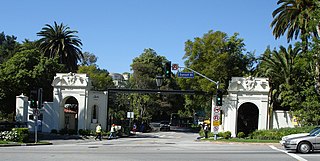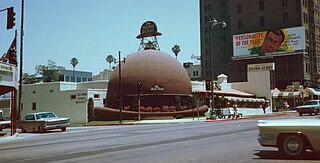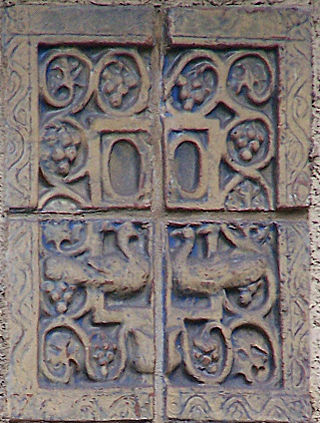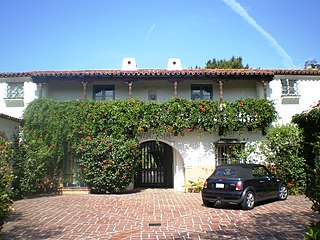
Hollywood is a neighborhood in the central region of Los Angeles County, California, mostly within the city of Los Angeles. Its name has come to be a shorthand reference for the U.S. film industry and the people associated with it. Many notable film studios, such as Sony Pictures, Walt Disney Studios, Paramount Pictures, Warner Bros. and Universal Pictures, are located near or in Hollywood.

Brentwood is a suburban neighborhood in the Westside region of Los Angeles.

The Watts Towers, Towers of Simon Rodia, or Nuestro Pueblo are a collection of 17 interconnected sculptural towers, architectural structures, and individual sculptural features and mosaics within the site of the artist's original residential property in Watts, Los Angeles, California, United States. The entire site of towers, structures, sculptures, pavement and walls were designed and built solely by Sabato Rodia, an Italian immigrant construction worker and tile mason, over a period of 33 years from 1921 to 1954. The tallest of the towers is 99.5 feet (30.3 m). The work is an example of outsider art and Italian-American naïve art.

Bel Air is a residential neighborhood on the Los Angeles Westside, in the foothills of the Santa Monica Mountains in the U.S. state of California. Founded in 1923, it is the home of the Hannah Carter Japanese Garden and the American Jewish University.

Echo Park is a neighborhood in the east-central region of Los Angeles, California. Located to the northwest of Downtown, it is bordered by Silver Lake to the west and Chinatown to the east. The culturally diverse neighborhood has become known for its trendy local businesses, as well as its popularity with artists, musicians and creatives. The neighborhood is centered on the eponymous Echo Park Lake.

Brown Derby was a chain of restaurants in Los Angeles, California. The first and best known was shaped like a derby hat, an iconic image that became synonymous with the Golden Age of Hollywood. It was opened by Wilson Mizner in 1926. The chain was started by Robert H. Cobb and Herbert K. Somborn in the 1920s. The original Brown Derby restaurants had closed or had been converted to other uses by the 1980s, though a Disney-backed Brown Derby national franchising program revived the brand in the 21st century. It is often incorrectly thought that the Brown Derby was a single restaurant, and the Wilshire Boulevard and Hollywood branches are frequently confused.

Amoeba Music is an American independent music store chain with locations in Berkeley, San Francisco, and Hollywood, Los Angeles, California. It stocks music and movies of every kind from popular hits to underground music. It is popular as a music lovers' tourist destination. It was founded in 1990 in Berkeley, California, and remains in operation, having survived the decline of CD sales in the 2000s.

Gower Street is a street in Los Angeles, California that has played an important role in the ongoing evolution of Hollywood, particularly as the home to several prominent Poverty Row studios during the area's Golden Age. It marks the eastern terminus of the Hollywood Walk of Fame.

Ernest Allan Batchelder was an American artist and educator who made Southern California his home in the early 20th century. He created art tiles and was a leader in the American Arts and Crafts Movement.
Valley Boulevard is a street in Southern California, running east from Los Angeles to Pomona, where it becomes Holt Avenue, and a continuation from Fontana to Colton. It generally parallels Interstate 10 (I-10) and State Route 60 (CA 60), and is the original alignment of U.S. Route 60 (US 60). The present north end of I-710 is at Valley Boulevard in Los Angeles, just west of Alhambra.

The Archer School for Girls is an independent, college preparatory girls' school for grades 6–12, located in West Los Angeles, California, United States. Archer currently enrolls 490 students from 79 different zip codes and 141 feeder schools.

Charmont Apartments is an historic five-story apartment building in Santa Monica, California which was built in 1928. Designed by architect Max Maltzman with elements of both the Mission Revival-Spanish Colonial Revival style and the Art Deco style, the Charmont was a luxurious high-rise when it was built. The blending of Spanish Colonial Revival and Art Deco elements was popular style in the 1920s and is sometimes known as "Med-Deco." The main entrance is located in a walled courtyard that features a two-tiered fountain with an intricate Moorish-patterned backsplash in polychrome tile.

The Andalusia is an apartment building located at 1471-1475 Havenhurst Dr. in Hollywood, Los Angeles, California, built in 1926 in Spanish Colonial Revival style. The building was listed in the National Register of Historic Places in 2003. Additionally, it is designated as Los Angeles Historic Cultural Monument No. 435.

El Cabrillo is a two-story, ten-unit Spanish-style courtyard condominium building located at the southeast corner of Franklin Avenue and Grace Avenue in Hollywood, Los Angeles, California. The Spanish Colonial Revival style building was designed by architects Arthur and Nina Zwebell and built in 1928 by movie mogul Cecil B. DeMille.

The Adamson House and its associated land, which was known as Vaquero Hill in the 19th century, is a historic house built by Rhoda Adamson and gardens in Malibu, California. The residence and estate is on the coast, within Malibu Lagoon State Beach park.

Los Angeles's 1st City Council district is one of the fifteen districts in the Los Angeles City Council. It is currently represented by Democrat Eunisses Hernandez since 2022, after she beat previous councilmember Gil Cedillo that year.

The Broadway Hollywood Building is a building in Los Angeles' Hollywood district. The building is situated in the Hollywood Walk of Fame monument area on the southwest corner of the intersection referred to as Hollywood and Vine, marking the intersection of Hollywood Boulevard and Vine Street. It was originally built as the B. H. Dyas Building in 1927. The Broadway Hollywood Building is referred to by both its main address of 6300 Hollywood Boulevard and its side address of 1645 Vine Street.

Gardens of the World is a botanical garden in Thousand Oaks, California, situated directly across Thousand Oaks Boulevard from Thousand Oaks Civic Arts Plaza, within the downtown core of the city. Established in 2001, the park was given to the city by the owners of a local travel agency. It is home to a French garden and waterfall, an English rose garden, an Italian grapevine garden and a Japanese garden with koi ponds and a pagoda. The park is used for walking and picnicking, and guided tours of the gardens are available. The Californian Mission Courtyard includes native California flora and murals of the remaining 21 California Missions. There is also a statue of Father Junipero Serra in this part of the park. The botanical garden is 4.5 acres (1.8 ha).
Victor Heights, sometimes referred to as the Forgotten Edge, is a neighborhood in Central Los Angeles.




















